![]()
![]()
![]()
Use LEFT and RIGHT arrow keys to navigate between flashcards;
Use UP and DOWN arrow keys to flip the card;
H to show hint;
A reads text to speech;
65 Cards in this Set
- Front
- Back
- 3rd side (hint)
|
Nekton
|
Organisms able to move independently of water currents
e.g. Fish, Cephalopods |
|
|
|
Benthic zone
|
Ecological region at the lowest level of a body of water
|
|
|
|
Infauna
|
Aquatic animals that live in the substrate of a body of water, especially in a soft sea bottom.
|
|
|
|
Epifauna
|
Aquatic animals that live on the bottom substratum as opposed to within it
Also called epibenthos |
|
|
|
Plankton
|
Organisms that live within the water column and do not have their own movement (or very little)
e.g. Zooplankton, Phytoplankton |
|
|
|
Spring tide
|
When the moon and sun are aligned
|
|
|
|
Neap tide
|
When the moon and sun are out of alignment
|
|
|
|
Pelagic zone
|
Any water in the sea that is not close to the bottom or near to the shore
|
|
|
|
Lichens
|
Symbiotic combination of yeasts and green algae or cyanobacteria
|
|
|
|
Phaeophyta
|
Brown seaweed
|
|
|
|
Largest seaweed
|
Kelp (brown algae)
Can exceed a length of 25m |
|
|
|
Brown seaweed pigments
|
Chlorophyll a and c
Carotenoids - inc. Fucoxanthin |
|
|
|
Rhodophyta
|
Red seaweed
|
|
|
|
Forms of red seaweed
|
Encrusting
Filamentous Erect branching Frondose |
|
|
|
Red seaweed pigments
|
Phycobilins - Phycocyanin, phycoerythrin
|
|
|
|
Chlorophyta
|
Green seaweed
|
|
|
|
Forms of green seaweed
|
Uncellular/filamentous
branched/frondose |
|
|
|
Green seaweed pigments
|
Chlorophyll a and b
|
|
|
|
Annelida
|
Segmented worms
|
|
|
|
Phylum/Sub-phylum?
Shrimps, Prawns, Crabs, Lobsters, Barnacles |
Arthropoda/Crustacea
|
|
|
|
Phylum?
Marine snails, oysters, clams, mussels & other bivalve shellfish, octopuses and squids |
Mollusca
|
|
|
|
Phylum?
Feather stars, starfishes, brittle stars, sea urchins, sea cucumbers |
Echinodermata
|
|
|
|
Examples of phytoplankton
|
Dinoflagellates
Diatoms |
|
|
|
Term for when populations grow in discrete pulses
|
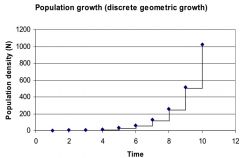
Geometric population growth
|
|
|
|
Equation which models geometric growth
|

|
|
|
|
Term for when a population grows with continuous time intervals
|
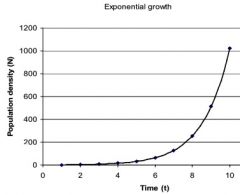
Exponential growth
|
|
|
|
Equation which models exponential growth
|

|
|
|
|
Population growth which slows and eventually stops as resources are depleted
|

Logistic population growth
|
|
|
|
Examples of density dependent factors on population growth
|
Mostly Biotic:
Disease Resource competition Predation |
|
|
|
Examples of density-independent factors on population growth
|
Mostly abiotic:
Flood Fire Extreme temperature |
|
|
|
Life history traits of r-selected species
|
Early reproduction
Many offspring Little or no parental care |
|
|
|
Life history traits of K-selected species
|
Delayed maturity
Few offspring Much parental care |
|
|
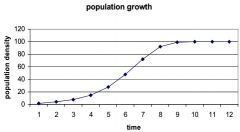
Name this curve
|

Sigmoidal curve
|
|
|
|
Evidence and consequences of Intra-specific competition in animals
|

|
|
|
|
Evidence of Intra-specific competition in grass
|
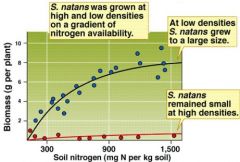
|
|
|
|
Inter-specific competition
|
Competition between individuals of two species that reduces the fitness of both
|
|
|
|
Self thinning
|
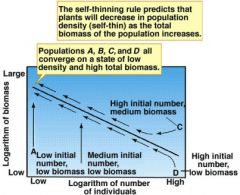
Reduction in population density as a stand of plants increases in biomass, due to intra-specific competition
|
|
|
|
Interference competition
|
Form of competition involving direct aggressive interaction between individuals
|
|
|
|
Niche
|
The environmental factors that influence the growth, survival and reproduction of a species
|
|
|
|
Fundamental niche
|
The physical conditions under which a species might live, in the absence of interactions with other species
|
|
|
|
Realised niche
|
The actual niche of a species whose distribution is restricted by biotic interactions such as competition, predation, disease and parasitism
|
|
|
|
The principle that two species with identical niches cannot coexist indefinitely
|
Competitive exclusion principle
(Gause's principle) |
|
|
|
Describes the condition in which populations or species have non-overlapping geographic ranges
|
Allopatric
|
|
|
|
Describes the condition in which populations or species have overlapping geographic ranges
|
Sympatric
|
|
|
|
Examples of mutualism
|
Coral reefs
Bioluminescence Animal pollination of plants Mycorrhizae Animal digestion |
|
|
|
a mutualistic association between a fungus and the roots of a vascular plant
|
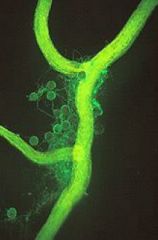
Mycorrhizae
|
|
|
|
Intracellular form of Mycorrhizae
|
AMF (arbuscular mycorrhizal fungus)
|
|
|
|
Extracellular form of Mycorrhizae
|
EcM (ectomycorrhizae)
|
|
|
|
Benefits to plants with Mycorrhizae
|
Greater access to inorganic nutrients (P, Cu, Zn, N)
Increases leaf water potential (May be due to increased access to Phosphorus) |
|
|
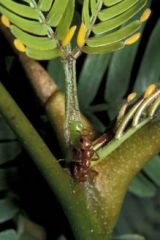
Example of a mutualistic relationship between ants and a tree
|

Acadia tree supplies shelter and food
Ants supply protection from grazers and encroaching vegetation = Tree grows faster and has increased chance of survival Obligate mutualism |
|
|

Example of a mutualistic relationship between ants and a sunflower
|
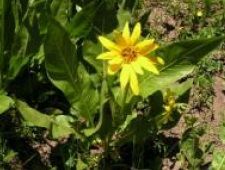
Aspen sunflower supplies sugars and amino acids
Ants reduce seed predation Facultative mutualism |
|
|
|
Species richness
|
The number of species in a community
(Regardless of relative abundance) |
|
|
|
Species evenness
|
The relative abundance of species in a community
|
|
|
|
Lognormal distribution
|
The normal distribution of relative abundances of species when each interval is doubled (pic)
|
|
|
|
Rank-abundance curve
|
A curve that portrays the number of species in a community and their relative abundance; constructed by plotting the relative abundance of species against their rank in abundance (pic)
|
|
|
|
Shannon-Weiner index
|

|
|
|
|
Simpson's index
|

|
|
|
|
Paradox of the plankton
|
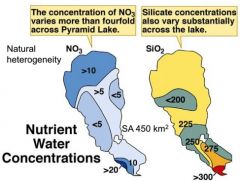
Heterogeneity or environmental complexity
|
|
|
|
Disturbance hypothesis
|
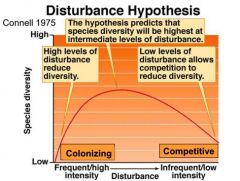
|
Sousa (1984) – “a discrete, punctuated killing, displacement or damaging of one or more individuals that directly or indirectly creates an opportunity for new individuals to become established.”
White & Pickett (1985) – “any relatively discrete event in time that disrupts ecosystem, community or pop. structure and changes resources, substrate availability or the physical environment.” |
|
|
Effect on species diversity by disturbance of of boulders on the intertidal
|
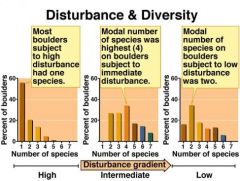
|
|
|
|
Experimental evidence of keystone species
|
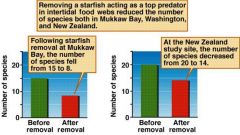
Experimental removal of starfish by Paine
|
|
|
|
Why keystone species increase biodiversity
|
Keystone species keep (dominant) prey populations below carrying capacity
-> Reducing potential competitive exclusion |
|
|
|
Results of Lubchenko's study of the effect of snail density on algal diversity
|
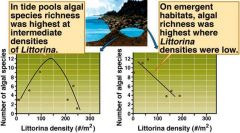
*
|
|
|
|
The difference between a keystone species and a dominant species
|
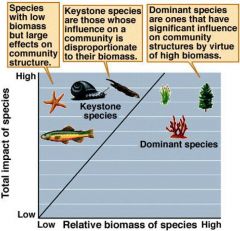
Both have a substantial impact of community structure but differ in biomass
|
|
|

Before
|
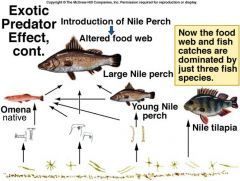
After
|
|

